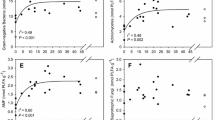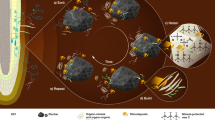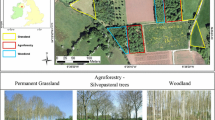Abstract
Sequestering carbon (C) into stable soil pools has potential to mitigate increasing atmospheric carbon dioxide concentrations. Carbon accrues in grassland soil restored from cultivation, but the amount of physically protected C (here measured as microaggregate-within-macroaggregate C) and predominant mechanisms of accrual are not well understood. We modeled the rate of physically protected carbon accrued in three mesic temperate perennial restored grasslands from cross-continental regions using datasets with a wide range of restoration ages from northeast Kansas, USA; southeast Nebraska, USA; and northeast Free State, South Africa. Further, we investigated major controls on the amount of physically protected C in each site using structural equation modeling. Variables in the structural equation model were root biomass, root C:N ratio, soil structure (indicated by bulk density, percent of macroaggregates on a per whole soil mass basis, and percent of microaggregate-within-macroaggregates on a per macroaggregate mass basis), microbial composition (indicated by microbial biomass C, total phospholipid fatty acid [PLFA] biomass, and PLFA biomass of arbuscular mycorrhizae fungi [AMF] biomass), and microaggregate-within-macroaggregate C on a per whole soil mass basis. Across all sites, physically protected C accrued at a rate of 16 ± 5 g m−2 year−1. Data from South Africa fit an a priori metamodel developed for northeast KS that hypothesized physically protected C could be explained as a function of microbial composition, soil structure, root C:N ratio, and root biomass (listed in order of strength of direct effect on physically protected C). In contrast to the model-based hypothesis, root C:N ratio was the strongest influence (negative) on physically protected C in South Africa. The lesser effect of AMF on physically protected C in South Africa was consistent with lower AMF biomass in arid environments. The hypothesized model did not fit southeast Nebraska data possibly due to high (~ 30%) clay content. Overall, these results suggest that physically protected C in soil with moderate amounts of clay (more than 10% and less than 30%) can be predicted with knowledge of roots (biomass and C:N ratio), microbial biomass, and soil aggregation.




Similar content being viewed by others
Data availability
Data used in this synthesis is available through the Environmental Data Initiative repository: https://doi.org/10.6073/pasta/6f05427623092f016cdf696d8c99c5cb. The dataset (before averaging to plot level) from the northeast Kansas, USA site (Scott et al. 2017) is included as electronic supplementary material. A site map of the northeast Kansas chronosequence is also included as electronic supplementary material.
Code availability
R code is available through the Environmental Data Initiative repository: https://doi.org/10.6073/pasta/6f05427623092f016cdf696d8c99c5cb.
References
Angers D, Caron J (1998) Plant induced changes in soil structure: processes and feedbacks. Biogeochemistry 42:55–72
Bach EM, Baer SG, Meyer CK, Six J (2010) Soil texture affects soil microbial and structural recovery during grassland restoration. Soil Biol Biochem 42:2182–2191
Baer SG, Birge H (2019) Soil ecosystem services: an overview. In: Reicosky D (ed) Managing soil health for sustainable agriculture. Burleigh Dodds Science Publishing Limited, Cambridge
Baer SG, Kitchen DJ, Blair JM, Rice CW (2002) Changes in ecosystem structure and function along a chronosequence of restored grasslands. Ecol Appl 12:1688–1701
Baer SG, Blair JM, Collins SL, Knapp AK (2003) Soil resources regulate productivity and diversity in newly established tallgrass prairie. Ecology 84:724–735
Baer SG, Meyer CK, Bach EM, Klopf RP, Six J (2010) Contrasting ecosystem recovery on two soil textures: implications for carbon mitigation and grassland conservation. Ecosphere 1:article 5
Baer SG, Bach EM, Meyer CK, Du Preez CC, Six J (2015) Restoration of cultivated soil in the Free State (South Africa) and comparison to Nebraska (United States) provides a global perspective of belowground ecosystem recovery in response to grassland restoration. Ecosystems 18:390–403
Bartoń K (2018) MuMIn: multi-model inference. R package version 1.40.4
Bates D, Maechler M, Bolker B, Walker S (2015) Fitting linear mixed-effects models using lme4. J Stat Softw 67:1–48
Bligh EG, Dyer WJ (1959) A rapid method of total lipid extraction and purification. Can J Biochem Physiol 37:911–917
Bossio DA, Scow KM, Gunapala N, Graham KJ (1998) Determinants of soil microbial communities: effects of agricultural management, season, and soil type on phospholipid fatty acid profiles. Microb Ecol 36:1–12
Canty A, Ripley B (2017) Boot: bootstrap R (S-Plus) functions. R package version 1.3–20
Cotrufo MF, Wallenstein MD, Boot CM, Denef K, Paul E (2013) The Microbial Efficiency-Matrix Stabilization (MEMS) framework integrates plant litter decomposition with soil organic matter stabilization: do labile plant inputs form stable soil organic matter? Glob Change Biol 19:988–995
Davidson AC, Hinkley DV (1997) Bootstrap methods and their applications. Cambridge University Press, Cambridge
DeGrood SH, Claassen VP, Scow KM (2005) Microbial community composition on native and drastically disturbed serpentine soils. Soil Biol Biochem 37:1427–1435
De Gryze S, Six J, Brits C, Merckx R (2005) A quantification of short-term macroaggregate dynamics: influences of wheat residue input and texture. Soil Biol Biochem 37:55–66
Denef K, Six J, Merckx R, Paustian K (2004) Carbon sequestration in microaggregates of no-tillage soils with different clay mineralogy. Soil Sci Soc Am J 68:1935–1944
Denef K, Zotarelli L, Boddey RM, Six J (2007) Microaggregate-associated carbon as a diagnostic fraction for management-induced changes in soil organic carbon in two Oxisols. Soil Biol Biochem 39:1165–1172
Dexter AR, Richard G, Arrouays D, Czyż EA, Jolivet C, Duval O (2008) Complexed organic matter controls soil physical properties. Geoderma 144:620–627
Ding Y, Liu YG, Liu SB, Huang XX, Li ZW, Tan XF, Zeng GM, Zhou L (2017) Potential benefits of biochar in agricultural soils: a review. Pedosphere 27:645–661
Du Toit ME, Du Preez CC, Hensley M, Bennie ATP (1994) Effect of cultivation on the organic matter content of selected dryland soils in South Africa. S Afr J Plant Soil 11:71–79
Ehrenfeld JG, Ravit B, Elgersma K (2005) Feedback in the plant–soil system. Annu Rev Environ Resour 30:75–115
Elliot ET, Coleman DC, Ingrahm RE, Trofymow JA (1984) Carbon and energy flow through microflora and microfauna in the soil subsystem of terrestrial ecosystems. In: Klug MJ, Reddy CA (eds) Current perspectives in microbial ecology. American Society for Microbiology, Washington, D.C., pp 424–433
Field CD, Evans CD, Dise NB, Hall JR, Caporn SJM (2017) Long-term nitrogen deposition increases heathland carbon sequestration. Sci Total Environ 592:426–435
Gale WJ, Cambardella CA, Bailey TB (2000) Root-derived carbon andthe formation and stabilization of aggregates. Soil Sci Soc Am J 64:201–207
Grace JB (2006) Structural equation modeling and natural systems. Cambridge University Press, Cambridge
Jastrow JD (1996) Soil aggregate formation and the accrual of particulate and mineral-associated organic matter. Soil Biol Biochem 28:665–676
Klopfenstein ST, Hirmas DR, Johnson WC (2015) Relationships between soil organic carbon and precipitation along a climosequence in loess-derived soils of the Central Great Plains, USA. Catena 133:25–34
Kong AYY, Six J, Bryant DC, Denison RF, van Kessel C (2005) The relationship between carbon input, aggregation, and soil organic carbon stabilization in sustainable cropping systems. Soil Sci Soc Am J 69:1078–1085
Kotzé E, Sandhage-Hofmann A, Amelung W, Oomen RJ, du Preez CC (2017) Soil microbial communities in different rangeland management systems of a sandy savanna and clayey grassland ecosystem, South Africa. Nutr Cycl Agroecosyst 107:227–245
Kuznetsova A, Brockhoff PB, Christensen RHB (2016) lmerTest: tests in linear mixed effects models. R package version 2.0–33
Lee J, Hopmans JW, Rolston DE, Baer SG, Six J (2009) Determining soil C stock changes: simple bulk density corrections fail. Agric Ecosyst Environ 134:251–256
Lenth R (2020) Emmeans: estimated marginal means, aka least-squares means. R package version 1.4.6
Lobe I, Amelung W, Du Preez CC (2001) Losses of soil carbon and nitrogen with prolonged arable cropping from soils of the South African Highveld. Eur J Soil Sci 52:93–101
Lobe I, Du Preez CC, Amelung W (2002) Influence of prolonged arable cropping on lignin compounds in sandy soils of the South African Highveld. Eur J Soil Sci 53:553–562
Loke PF, Kotzé E, Du Preez CC, Twigge L (2020) Cross-rangeland comparisons on soil carbon dynamics in the pedoderm of semi-arid and arid South African commercial farms. Geoderma 381:114689
Matamala R, Jastrow JD, Miller RM, Garten CT (2008) Temporal changes in C and N stocks of restored prairies: implications for C sequestration strategies. Ecol Appl 18:1470–1488
McLauchlan K (2006) The nature and longevity of agricultural impacts on soil carbon and nutrients: a review. Ecosystems 9:1364–1382
Melas GB, Ortiz O, Alacaniz JM (2017) Can biochar protect labile organic matter against mineralization in soil? Pedosphere 27:822–831
Newman EI (1985) The rhizosphere: carbon sources and microbial populations. In: Fitter AH (ed) Ecological interactions in soil: plants, microbes and animals. Special Publication of the British Ecological Society 4. Blackwell Scientific, Oxford, pp 107–121
Paustian K, Andren O, Janzen HH, Lal R, Smith P, Tian G, Tiessen H, Van Noordwijk M, Woomer PL (1997) Agricultural soils as a sink to mitigate CO2 emissions. Soil Use Manag 13:230–244
Puget P, Drinkwater LE (2001) Short-term dynamics of root- and shoot- derived carbon from a leguminous green manure. Soil Sci Soc Am J 65:771–779
R Core Team (2016) R: a language and environment for statistical computing. R Foundation for Statistical Computing, Vienna
Robinson GS, Jacques WA (1958) Root development in some common New Zealand pasture plants. New Zeal J of Agr Res 1:199–216
Rosenzweig ST, Carson MA, Baer SG, Blair JM (2016) Changes in soil properties, microbial biomass, and uxes of C and N in soil following post-agricultural grassland restoration. Appl Soil Ecol 100, 186–194. https://doi.org/10.1016/j.apsoil.2016.01.001
Rosseel Y (2012) Lavaan: an R package for structural equation modeling. J Stat Softw 48:1–36
Scott NA (1998) Soil aggregation and organic matter mineralization in forests and grasslands: plant species effects. Soil Sci Soc Am J 62:1081–1089
Scott DA, Baer SG, Blair JM (2017) Recovery and relative influence of root, microbial, and structural properties of soil on physically sequestered carbon stocks in restored grassland. Soil Sci Soc Am J 81:50–60
Scott DA, Rosenzweig ST, Baer SG, Blair JM (2019) Changes in potential nitrous oxide efflux during grassland restoration. J Environ Qual 48:1913–1917
Simpson RT, Frey SD, Six J, Thiet RK (2004) Preferential accumulation of microbial carbon in aggregate structures of no-tillage soils. Soil Sci Soc Am J 68:1249–1255
Six J, Paustian K (2014) Aggregate-associated soil organic matter as an ecosystem property and a measurement tool. Soil Biol Biochem 68:A4–A9
Six J, Paustian K, Elliott ET, Combrink C (2000a) Soil structure andorganic matter: I. Distribution of aggregate-size classes and aggregate-associated carbon. Soil Sci Soc Am J 64:681–689
Six J, Elliot ET, Paustian K (2000b) Soil macroaggregate turnover and microaggregate formation: a mechanism for C sequestration under no-tillage agriculture. Soil Biol Biochem 32:2099–2103
Six J, Feller C, Denef K, Ogle SM, de Moraes Sa JC, Albrecht A (2002) Soil organic matter, biota and aggregation in temperate and tropical soils—effects of no-tillage. Agronomie 22:755–775
Six J, Bossuyt H, Degryze S, Denef K (2004) A history of research onthe link between (micro)aggregates, soil biota, and soil organic matterdynamics. Soil Tillage Res 79(1):7–31
Smith AP, Marín-Spiota E, de Gra MA, Balser TC (2014) Microbial community structure varies across soil organic matter aggregate pools during tropical land cover change. Soil Biol Biochem 77:292–303
Smucker AJM, Safir GR (1986) Root and soil microbial interactions which influence the ability to photoassimilate carbon to the rhizosphere. In: Mitchell MJ, Nakas JP (eds) Micro oral and faunal interactions in natural and agroecosystems. Junk Publishers, Dordrecht, pp 203–244
Stewart CE, Paustian K, Conant RT, Plante AF, Six J (2007) Soil carbon saturation: concept, evidence and evaluation. Biogeochemistry 86:19–31
Theng BKG (1974) The chemistry of clay-organic reactions. Hilger, London
Theng BKG (1979) Formation and properties of clay-polymer complexes. Elsevier, Amsterdam
Tisdall JM, Oades JM (1982) Organic matter and water-stable aggregates in soils. J Soil Sci 33:141–163
USDA National Cooperative Soil Survey (2008) Wymore series. USDA National Cooperative Soil Survey, Waverly
USDA National Cooperative Soil Survey (2020) Arispe series. USDA National Cooperative Soil Survey, Waverly
Wang D, Fonte S, Parikh SJ, Six J, Scow KM (2017) Biochar additions can enhance soil structure and the physical stabilization of C in aggregates. Geoderma 303:110–117
Wilson GWT, Hartnett DC (1998) Interspecific variation in plant responses to mycorrhizal colonization in tallgraaa prairie. Am J Bot 85:1732–1738
Wilson GWT, Rice CW, Rillig MC, Springer A, Hartnett DC (2009) Soil aggregation and carbon sequestration are tightly correlated with the abundance of arbuscular mycorrhizal fungi: results from long-term field experiments. Ecol Lett 12:452–461
Xue P-P, Carrillo Y, Pino V, Minansy B, McBratney AB (2018) Soil properties drive microbial community structure in a large scale transect in South Eastern Australia. Sci Rep 8:11725
Yu Z, Lu C, Hennessy DA, Feng H, Tian H (2020) Impacts of tillage practices on soil carbon stocks in the US corn-soybean cropping system during 1998 to 2016. Environ Res Lett 15:014008
Zak DR, Holmes WE, Burton AJ, Pregitzer KS, Talhelm AF (2008) Simulated atmospheric NO3– deposition increases soil organic matter by slowing decomposition. Ecol Appl 18:2016–2027
Zhang J, Wang F, Che R, Wang P, Liu H, Ji B, Cui X (2016) Precipitation shapes communities of arbuscular mycorrhizal fungi in Tibetan alpine steppe. Sci Rep 6:23488
Zhao C, Miao Y, Yu C, Zhu L, Wang F, Jiang L, Hui D, Wan S (2016) Soil microbial community composition and respiration along an experimental precipitation gradient in a semiarid steppe. Sci Rep 6:24317
Acknowledgements
Amanda Rothert assisted with lab analyses.
Funding
No funding was provided for this synthesis work.
Author information
Authors and Affiliations
Corresponding author
Ethics declarations
Conflict of interest
The authors declare no conflict of interest.
Additional information
Responsible Editor: William R. Wieder.
Publisher’s Note
Springer Nature remains neutral with regard to jurisdictional claims in published maps and institutional affiliations.
Supplementary Information
Below is the link to the electronic supplementary material.
Rights and permissions
About this article
Cite this article
Scott, D.A., Bach, E.M., Du Preez, C.C. et al. Mechanisms influencing physically sequestered soil carbon in temperate restored grasslands in South Africa and North America. Biogeochemistry 156, 131–143 (2021). https://doi.org/10.1007/s10533-021-00774-y
Received:
Accepted:
Published:
Issue Date:
DOI: https://doi.org/10.1007/s10533-021-00774-y




